 |
|
Operation Crossroads - 1946
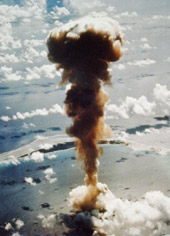 Operation Crossroads was a two shot nuclear testing series conducted in the summer of 1946. Crossroads was the first post-World War 2 nuclear testing series conducted by the United States, and the first nuclear weapons effects tests ever conducted. The atomic bombings of Hiroshima and Nagasaki provided an opportunity to study the effects of a nuclear explosion on a city, however, the effects of a nuclear explosion on ships were still unknown. For this reason, the series sought to study the effects of a nuclear explosion upon naval ships of various sizes and other military and civilian equipment.
Operation Crossroads was a two shot nuclear testing series conducted in the summer of 1946. Crossroads was the first post-World War 2 nuclear testing series conducted by the United States, and the first nuclear weapons effects tests ever conducted. The atomic bombings of Hiroshima and Nagasaki provided an opportunity to study the effects of a nuclear explosion on a city, however, the effects of a nuclear explosion on ships were still unknown. For this reason, the series sought to study the effects of a nuclear explosion upon naval ships of various sizes and other military and civilian equipment.
Crossroads was seen as a means to measure the effectiveness of current naval power against atomic weapons, and determine if the development of nuclear weapons rendered the U.S. Navy obsolete. The nuclear tests sought answers to many questions, including to what amount and type of damage would the bombs produce in the first instance, to what extent should accepted principles of ship design be altered in future construction, what defensive measures could be taken by a ship attacked with atomic weapons, and whether traditional tactical practices were outdated.
Operation Crossroads was the idea of Lewis Strauss, an aide to Secretary of Navy James Forrestal, and later Chairman of the U.S. Atomic Energy Commission. Early in 1944 the Manhattan Engineer District had given serious consideration to the possibility of testing an atomic bomb against the Japanese Navy at Truk Island. After the surrender of Japan, Senator Brien McMahon of Connecticut made a speech to the Senate in which he advocated the use of an atomic bomb against the captured Japanese fleet. Eventually, it was decided to use obsolete U.S., as well as captured Japanese and German vessels, for the Crossroads experiments.
Presidential approval was given on 10 January 1945 to create Joint Task Force One (JTF 1). The purpose of JTF 1 was to organize and conduct nuclear tests in the Pacific during Operation Crossroads. Vice Admiral W.H.P Blandy was designated as Commander of JTF 1 (CJTF 1). Long distinguished in the field of ordnance engineering, and Chief of the Bureau of Ordnance from 1941 to 1943, Admiral Blandy saw action in the Pacific, was latterly Deputy Chief of Naval Operations, Special Weapons. Over 200 ships, 42,000 men, and 150 aircraft comprised the Task Force and included members of the Navy, Army Air and Ground Forces, and civilian scientists. Crossroads was publicly announced in December 1945. Vice Admiral Blandy gave an outline of the planned operation to the Special Committee on Atomic Energy. Over $70 million dollars would be spent on Operation Crossroads.
At least two tests were required, though as many as three or four were originally planned. One test would be conducted in the atmosphere, several hundred feet above a target array. This test, code named Able, would study the response of various ships, equipment, and material against the effects of blast, thermal radiation, and radioactivity. A second test, code named Baker, would be fired underwater, with the ships of the target array at various distances from the epicenter. Baker sought to study the same effects as those studied for the Able shot.
"The bomb will not start a chain-reaction in the water converting it all to gas and letting the ships on all the oceans drop down to the bottom. It will not blow out the bottom of the sea and let all the water run down the hole. It will not destroy gravity. I am not an atomic playboy, as one of my critics labeled me, exploding these bombs to satisfy my personal whim."
- Vice Admiral W.H.P. Blandy, Commander of Joint Task Force One
|

Target Fleet
|
Over 90 target vessels would comprise the target array which would be exposed to the nuclear shots. These ships ranged in size from small, amphibious craft to aircraft carriers and battleships. Several plans for the arrangement of the target fleet were considered and revised. The directive creating Operation Crossroads specified a disposition of ships to give a graduation of damage from maximum to minimum. Major damage to ships close to the explosion point, minor damage to ships at the outskirts of the target circle, would provide valuable means of analyzing the bomb’s destructive force.
Ships within the 500 yard radius around ground zero would be secured by fixed moorings fore and aft to prevent swinging. For Able, these ships included the heavy cruiser USS Pensacola, destroyer USS Hughes, Japanese battleship Nagato, light carrier USS Independence, submarine USS Skate, district craft YO-160, Japanese light cruiser Sakawa. Ships outside the 500 yard radius were anchored free to swing. Vessels anchored between the 1,000 yard and 4,000 yard boundary were disposed in a spoke like pattern around ground zero. These included rows of LSTs, LCTS, LCIs, two rows of transports, and one row of destroyers.
The concentration of ships from a Navy standpoint was artificial. More than 20 ships were compressed within 1,000 yards of ground zero. Ordinarily such an area would be used to contain but a single capital ship in a carrier force at sea, or three capital ships in a normal anchorage. The principle of using an arrangement that would provide graduated damage, instead of one representing a tactical formation or anchorage, was followed in both tests.
The tests, originally scheduled for May 15, 1946, were postponed six weeks by President Truman, to July 1, in order that members of Congress would be able to observe the shots. This delay gave more time for planning and preparations.
"The atom bomb is here. It exists. We must look to the future. Up until now only three have been exploded, and none over the water. It is the duty of the military services to explore the military might of this new weapon. We want to be prepared for any use of atomic energy that may become necessary, whether offensive or defensive."
- Major General W.E. Kepner, Deputy Task Force Commander for Aviation
|
Bikini Atoll was chosen as the location for the nuclear tests to be fired during Operation Crossroads. The atoll is situated in the Marshall Islands group, in the western Pacific Ocean, some 3.200 km southwest of Hawaii and 6,700 km from San Fransisco. Several reasons motivated the decision to locate Operation Crossroads at Bikini. The atoll had an ideal size for the operation, average water depth inside the lagoon was approximately 60 meters and provided good anchorage for the target fleet. Bikini is located some 400 km north of Kwajalein, a suitable base from which the bombing plane could operate. The atoll is remote from fishing and steamer lanes and has excellent weather conditions.
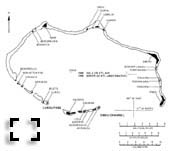
Bikini Atoll
|
167 native Bikinians were living on the atoll at the time preparations for the Crossroads were being made. In February 1946, Commodore Ben H. Wyatt, the military governor of the Marshall Islands, traveled to Bikini to meet with the natives and discuss their relocation for the nuclear tests. On a Sunday, after church service, the Bikinians were assembled and they would be temporarily relocated for Operation Crossroads. King Juda, the leader of the Bikinians, deliberated with his people for some time and stood before the American delegation and announced his people would leave the atoll for the tests.
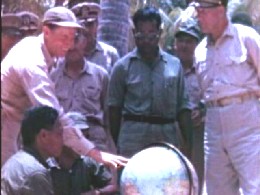
US plans being explained to King Juda
|
The Bikini church and community house were dismantled and transported to Rongerik. Pandanus thatching for the new village on Rongerik was prefabricated. New housing was constructed by U.S. Personnel and the natives. Nine concrete cisterns for catching rainwater were built. A total of 87,000 liters of fresh water was put ashore at Rongerik to tide the village until the beginning of the rainy season. The U.S. Navy gave the natives a radio, powered by a small generator, from which they could listen to regular noonday broadcasts from Station WXLG on Kwajalein. Rongerik affairs were watched over by military government officials under the Kwajalein Island Commander.
Life for the Bikinians on Rongerik deteriorated rapidly however. The islands of Rongerik Atoll were uninhabited because the Marshallese people considered them to be unlivable due to their size; Rongerik atoll is about 1/6 the size of Bikini Atoll. There was also a deep rooted traditional belief that the atoll was inhabited by evil spirits, called the Demon Girls of Ujae. Food supplies, good for several weeks, were left for the natives, but they soon discovered that the coconut trees and other local food crops produced very few fruits when compared to the yield of the trees on Bikini. The fish in the Rongerik lagoon were found to be inedible. Within two months of their arrival on Rongerik, the natives began to beg US officials to move them back to Bikini.
Planning for Operation Crossroads went forward during the spring and early summer of 1946. Surveys of the Bikini lagoon were made and its waters combed for old Japanese mines. The surveys also charted the location of coral heads, which presented distinct obstructions for navigation and anchorage of the fleet. It was also necessary to remove coral from the lagoon floor for accurate studies of underwater shock waves produced by the nuclear explosions. These coral heads were blasted with explosives at Bikini from the lagoon floor. Over 100 tons of dynamite was used for coral head removal. The islands were sprayed with DDT to insure healthy conditions for the Task Force personnel. The airfield at Kwajalein was made ready for the arrival of the Air Group. Laboratories for chemical analysis and photograph processing were constructed.
Kwajalein Atoll played a significant part in Operation Crossroads. For the purposes of the operation new asphalt plane parking areas were prepared, special fire-fighting systems were installed along the runway and special facilities were constructed for servicing the atomic bomb. The airstrip on Kwajalein also served as the main base for “Dave's Dream”, the aircraft selected to deliver the atomic bomb.
For the 42,000 men of Joint Task Force One, daily rations and requirements included 70,000 candy bars, 18,000 kg of meat, 40,000 kg of vegetables, 1,800 kg of coffee, 17,000 kg of fruit, and 30,000 cigarettes. A recreation area at Bikini, constructed in March of 1946, included a beer garden, ice cream parlor, swimming beach, softball diamonds, courts for horse shoe pitching and volley ball, and table tennis. On the carrier Saidor the airplane elevator, raised to a level three feet above the main hanger deck, served as an improvised boxing ring for the servicemen.
The Task Force ships began to arrive at Bikini one by one. Most of these ships arrived via Pearl Harbor, which was humming with activity in preparation for Crossroads. Other Naval yards used for Crossroads preparations were Philadelphia, Terminal Island, San Francisco, Mare Island, Bremerton. The majority of the ships that sailed to Bikini would comprise the target “ghost” fleet, which would be exposed to the nuclear detonations. Since these ships were themselves scientific instruments of a grand scale it was necessary to place the ships, and their equipment and machinery, in good working order so the injury produced by the explosions could be accurately determined. Power plants, machinery, guns, turrets, and other equipment were placed in the best condition possible, and the watertightness of compartments tested and improved. Army trucks and tanks were hoisted aboard and made fast. Sturdy brackets and pedestals were installed to support the thousands of instruments to be mounted when the ships reached Bikini.
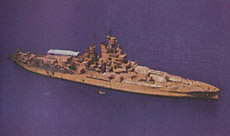
USS Nevada
|
The USS Nevada, painted bright orange for the tests, served as the target ship for the Able test. The battleship Pennsylvania, once a flagship of the U.S. fleet, was one of the five heavy ships in the target array. She served the United States for 29 years and was among the ships damaged at Pearl Harbor. The USS Saratoga, was one of two carriers that made up the target array; the other carrier was the USS Independence.
The USS Arkansas was also to be used in the target array and carried a variety of instruments for measuring the nuclear explosions. The rugged supports on the starboard deck and on the top of the gun turret served as a base for aluminum foil gages used to measure shock waves. Ground Forces equipment placed on various target ships, including the Arkansas, included heavy tanks, delicate radar and sound devices, flash proof clothing, fresh and canned rations, fuel and lubricants and numerous kinds of ammunition. Other ships used in the target array included the heavy cruisers USS Pensacola and USS Salt Lake City, and submarines Skate, Searaven, Skipjack, Tuna, Dentuda, Apogon, Pilotfish, and Parche.
The German cruiser Prinz Eugen was one of the three foreign ships used in the target array. She was the second of the Admiral Hipper-class heavy cruisers built during World War II. She saw action in several important naval battles in the Atlantic, Baltic Sea, and English Channel, including the engagement in 1941 which resulted in the sinking of the Bismark.
Other foreign ships included the Japanese battleship Nagato and light cruiser Sakawa. The Nagato was Admiral Isoroku Yamamoto's flagship, from which he heard the final code signal, "Tora! Tora! Tora!", informing him that the attack he engineered on Pearl Harbor was underway. From 6 February through 11 May 1946, some 180 U.S. Personnel readied the Nagato for her voyage to Bikini for Operation Crossroads. She arrived at Bikini in late April following three weeks of repairs at Enewetak.
The ships themselves were the main instruments of the operation. Their recorded behavior and response to nuclear detonations would reveal much of the nature of the forces created. Some of the instruments on the ships included those that measured roll and pitch, recorded strain experienced by plates and ribs, measured temperature of ship interior and, tested surrounding air for radioactive contamination. These measurements would be transmitted by radio to the observer fleet miles outside the lagoon.

Goats penned on the USS Nevada
|
3,030 rats, 176 goats, 57 guinea pigs, 109 mice, and 146 pigs were to be exposed during the experiments. They were placed on 22 target ships, in positions normally occupied by ship personnel. Some of these animals were dressed in clothing of various type and covered in anti-flash lotions and creams for biomedical thermal radiation studies. The National Cancer Institute supplied white mice with predilections for or against cancer. They were exposed in order to determine whether the intense radiations would produce genetic changes. The mice were returned to the Institute immediately after Able shot to be bread and studies. For the Baker shot, only 200 white rats and 20 pigs were used on four target vessels. Animals used for the Able shot were not used in the Baker shot.
Unmanned, radio-controlled boats and planes played an important part in the instrumentation aspect of the operation. The drone boats would enter the contaminated areas while it was still too ‘hot’ for human access and collect samples of water. Drone aircraft penetrated the mushroom cloud to collect radiochemical samples, performed photographic missions, and televised their instrument panel readings to remote onlookers.
Operation Crossroads was a landmark in photography. Cameras, both still and motion picture, recorded the nuclear explosions and all its effects from every possible angle. Over 18 tons of photographic equipment was used for Crossroads. The Army Air Force camera roster totaled 328, including aerial motion and still cameras. More than 50,000 still and 500,000 meters of motion picture film were exposed during Crossroads. Enough film was exposed in a few seconds during Crossroads for 11 full length Hollywood productions. One camera, the world’s largest aerial camera at the time, used a 122 cm focal length telephoto lens capable of taking a legible photograph of the dial of a wrist watch half a kilometer away. Small gun sight cameras were also used to record the explosions. One high-speed camera operated at the rate of 10,000 frames per second.
The multiplicity of cameras was necessary to insure a wide variety of filter combinations, lenses, and exposures, and in general to ensure obtaining full records of results, particularly damage results. Two cameras were installed in gun turrets in F-13 aircraft. These cameras were controlled from the top fire control blister on the fuselage. These F-13 photographic aircraft used 16mm and 35mm type motion picture cameras capable of recording 2,000 frames per second.
Rows of cameramen aimed their cameras down into the lagoon from C-54 aircraft. During shot Able the primary and secondary shockwaves were forceful enough to knock down one photographer caught off balance. These C-54 photographic planes had special apertures made in the fuselage to accommodate the cameras. Some of these planes carried as many as 28 cameras, still and motion picture.
 Photographic planes had to be exactly at their prescribed positions and altitudes, and on the prescribed course, at the time of the bomb drop to permit accurate concentration of cameras on the designated parts of the target area. Accuracy of timing required great cooperation of air crews and photographers. This accuracy was achieved by through careful and detailed planning, and through rehearsals first held at Albuquerque, N.M, and later at the Marshalls. To supplement the roster of photographers an appeal was made to ex-servicemen with experience in photography to leave their civilian jobs temporarily and help during Operation Crossroads. Nearly one-half of the final photographic staff consisted of veterans brought back from civilian life.
Photographic planes had to be exactly at their prescribed positions and altitudes, and on the prescribed course, at the time of the bomb drop to permit accurate concentration of cameras on the designated parts of the target area. Accuracy of timing required great cooperation of air crews and photographers. This accuracy was achieved by through careful and detailed planning, and through rehearsals first held at Albuquerque, N.M, and later at the Marshalls. To supplement the roster of photographers an appeal was made to ex-servicemen with experience in photography to leave their civilian jobs temporarily and help during Operation Crossroads. Nearly one-half of the final photographic staff consisted of veterans brought back from civilian life.
Ace photographers from Acme, International News Service, Associated Press, and Life Magazine were assigned to cover the tests. Photographs were handled under a pool agreement, all pictures in the pool being freely usable by pool members. The problem of security in releasing photographs was handled by a photographic panel representative of the varied responsibilities of the Task Force. At test Able were 166 newsmen, including 10 representatives of the foreign press. Two writers, one from the independent press and one from the wire services, were selected by the correspondents to write accounts of the tests as viewed from the air.
Cameras were also installed in the radio-controlled drone aircraft. B-17 drones had television cameras installed where the bomb sights would normally be located in the plexi-glass nose of the aircraft. These television cameras relayed what the drone plane saw to receivers miles away. The received images were studied by scientists and recorded on motion picture film. Television images of the drone’s instrument panel also helped the remote-control personnel keep the aircraft flying smoothly.
The extreme humidity at Bikini presented a problem for the aerial photographers. As the photographic aircraft descended and the air pressure in the cabin increased, moisture would condense on the photographic film, destroying the emulsion. To avoid this problem, pilots descended very slowly, sometimes over a period as great as one hour. In many planes the difficulty was avoided by installing cameras in constant pressure chambers.
At Kwajalein a huge photographic laboratory was built. The building was cooled and dehumidified to prevent damage to the film. The majority of photographic work was done at the U.S. Naval Photographic Science Laboratory at Anacosita, D.C. Photographic training was conducted at San Diego by Navy carrier-based pilots. These pilots later made photo mosaics of Bikini Atoll and flew many photographic missions before and after each nuclear test, recording locations and conditions of target ships. In some of this work tri-metrogon cameras were used. These cameras are technically three separate cameras, with one lens pointed vertically downwards and the other two pointed to the left and right to cover all the remaining field from horizon to horizon. For this photographic work, the Navy used six Navy F6F-5Ps, four TBMs, three PBMs, and four F6F drones. Cameras in these planes were in some instances accurately synchronized with cameras on towers and on surface ships in order to show the test from various angles at the same instant.
|
Operation Crossroads - Photography
More than 50,000 still and 500,000 meters of motion picture film were exposed during Crossroads. Since the fourth and fifth nuclear explosions ever fired were during Crossroads, every effort was made to make extensive visual records.
- Click on thumbnails for a larger version
|
Instrumentation was installed on top of steel towers erected on various islands surrounding the Bikini lagoon. Television cameras on these towers were focused on the target array and transmitted their signals in real time to receivers miles away during the moment of the explosions. Still and motion picture cameras were also installed in these towers. Towers were assembled on the ground and hoisted into place. Cameras were installed inside lead-walled vaults, the doors of which were arranged to close automatically after filming had been accomplished, to protect the film from the damaging effects of gamma radiation. Cameras were started remotely prior to the shots.
Dr. Marshall Hollowway headed the Los Alamos Laboratory group at Bikini. He was charged with the heavy responsibility of preparing the two atomic bombs used in the Crossroads tests. Dr. Ernest Titterton, a British scientist and one of Dr. Hollowway's principle assistants, was appointed to advise the Naval Research Laboratories in Washington, D.C. on the timing requirements. Despite the passing of the McMahon Act, which prohibited all but U.S. nationals from working on nuclear weapons, Titterton and another British scientist, William Penney, were asked to serve on Operation Crossroads due to their expertise in timing measurements and shock-wave studies, respectively. Titterton became very popular with the crew of the ship he sailed on to Bikini as he gave them simple lectures on the bomb tests. He also repaired the ship's movie projector.
In preparation for the Crossroads nuclear tests, a number of scaled model experiments were conducted at the Taylor Model Basin near Washington, D.C. To aid in estimating the size and character of waves that would be produced by the actual atomic detonations. Scale model ships were constructed of thin sheets of brass and floated in the test pool. Scaled amounts of TNT were used to simulate the atomic explosions. These tests were made in a specially constructed tank known as “Little Bikini”. Other studies were made on a larger scale, using more explosives, in tests conducted at the Naval Mine Warfare Test Station at Patuxent, Maryland. In both types of scaled experiments effects noted were the size of the water crater, height, persistency and diffusion of plumes.
Tail markings of B-29 aircraft served to identify their specific functions as part of Task Force Group 1.5. “F” markings indicated B-29s modified for use as photographic platforms. An arrow in a circle marked a plane used to drop air-pressure gages from high altitude during the first test. A “B” stood for a B-29 bomber. “W” identified weather planes.
Ten representatives and four Senators journeyed to Bikini to the view the tests. Two of the Senators, Carl A. Hatch of New Mexico and Leverett Saltonstall of Massachusetts, were members of the President's Evaluation Commission set up by President Truman to supplement the Evaluation board created by the Joint Chiefs of Staff. Eleven foreign nations had members that made up the United Nations Foreign Observer Group. These countries included Australia, Brazil, Canada, China, France, Egypt, Great Britain, Mexico, Netherlands, Poland, and the U.S.S.R.
|
Dave's Dream
 Winners of a hotly contested competition in which the country's finest very-heavy-bomber crews took part, the crew of the B-29 bomber Dave's Dream won the mission to drop the Able bomb during Operation Crossroads. This aircraft was originally called Big Stink.
Winners of a hotly contested competition in which the country's finest very-heavy-bomber crews took part, the crew of the B-29 bomber Dave's Dream won the mission to drop the Able bomb during Operation Crossroads. This aircraft was originally called Big Stink.
It participated in the atomic bombing on Nagasaki on August 9, 1945. Assigned to the 393rd Bomb Squadron, 509th Composite Group, it was used as a camera plane in support of the bomb-carrying aircraft called Bockscar, to photograph the explosion and effects of the bomb, and also to carry scientific observers.
Built at the Glenn L. Martin Aircraft Plant at Omaha, Nebraska, the aircraft was accepted by the Army Air Forces on April 20, 1945, and flown to Wendover Army Air Field, Utah in May. It departed Wendover for Tinian on June 19 and arrived on June 24. There it was assigned victor number 10, but that was changed for security reasons to victor 90 on August 1. On July 23, 1945, with Col. Paul Tibbets at the controls, it dropped a dummy Little Boy bomb assembly off Tinian to test its radar altimeter detonators.
After the war it served with the 509th CG at Roswell Army Air Field. In April 1946, after being assigned to Operation Crossroads, it was renamed Dave's Dream by its crew in honor of Captain David Semple, a bombardier who had been killed in the crash of another B-29 on March 7, 1946, near Albuquerque, New Mexico. Semple had been a bombardier in many of the 155 test drops for the Manhattan Project.
|
|
The Tests
|
Shot Able

Able - 1st July 1946
|
The first shot of Operation Crossroads, Able, was an air drop of a Mk-3 plutonium implosion bomb over the target array of ghost ships. This was the world's fourth nuclear explosion, second nuclear test, and first weapons effects test.
By mid-June the Task Force was in place. The Durleson, with its cargo of experimental animals, was one of the last arrivals (14th June). Several small scale-rehearsals were done in preparation from Able Day.
On Queen Day, the eighth day before the Able test, a complete dress rehearsal was staged. The bombing plane made its runs, dropping a flash-powder bomb which went off near the target ship Nevada at 0914. In the air, manned and unmanned planes followed the courses prescribed in the Air Plan prepared 3 months before. Vital to the success of Queen Day was the evacuation on the previous day of the 42,000 men of the Task Force from the target vessels, the Lagoon, and encircling islands. Every man had to be ccounted for, including the technicians who had made hurried, last minute adjustments on the
scientific instruments on the target array and islands.
Favorable weather conditions were necessary before shot day. On the day preceding Able Day, and on Able Day itself, three special weather reconnaissance missions were made. Daily weather conferences were held between forecasters at Kwajalein and Captain A.A. Cumberledge, USN, and Col. B. G. Holtzman at Bikini.
At the morning weather conference on 30 June 1946, favorable weather was forecast for the following day, so Admiral Blandy set 0830, 1 July 1946 as shot time. At the evening weather conference, conditions still appeared favorable. However, fairly heavy cloud cover was reported early on the morning of 1 July, and shot time was changed to 0900.
Evacuation of Task Force support ships began soon after CJTF 1 set the hour for Able. All destroyers except USS Moale got underway and were clear of the lagoon by early afternoon on 30 June. Most of the support ships of TG 1.2 were out of the lagoon shortly thereafter. Small craft had evacuated Task Force personnel from Enidrik and Eneman islands and transferred them to Fall River, which then left the lagoon along with the smaller ships of TG 1.2. Ten ships remained in the lagoon after 1800 hours.
Preparations ashore had included removal the roofs of buildings to prevent blast damage and removal of the pontoon-supported docks and causeways that had been installed on the islands. Machinery such as refrigerators, generators, and water-distilling units had been covered by tarpaulins.
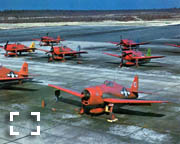
F6F-5K drone aircraft
|
USS Chilton evacuated 691 nonessential personnel and natives from Enewetak before the test. Provision had been made to evacuate essential U.S. personnel on Enewetak if necessary, and five C-54 air transports were at Enewetak for this purpose. The Marshallese on Rongerik to the east had been taken aboard USS LST-989 in case evacuation was necessary there.
Two additional C-54s were sent from their Kwajalein base on 30 June, one to Enewetak and one to Roi Island. These were scheduled to receive the radioactive cloud samples to be collected by the B-17 drone samplers based at Enewetak and the F6F drone samplers returning it following the shot.
Non-target small craft were moored (unmanned) in the lagoon off Eneu Island about 5 nmi south of the test area. Among these were several drone boats equipped to be remotely controlled. After each detonation the drones were guided by aircraft and USS Beqor to areas in the target array to collect water samples and take radiation readings. After the water samples were collected, the drones were guided back to Begor where they were hosed down to remove radioactive contamination and retrieve samples.
After each test the drones were followed by six patrol motor gunboats (EMS) and twenty landing craft (LCPLs) with radiation monitors aboard. Radiation intensity measurements were sent by radio to the Radsafe Control Center. From this information and that gathered from aircraft equipped with radiation detectors, it was determined when a safe reentry to the lagoon by the main body of the fleet could be.
The first airborne aircraft were three B-29s that had made weather reconnaissance flights in the shot area and northeast and northwest of Bikini Atoll. At 0540 CJTF 1 ordered the drop aircraft to take off from Kwajalein, which had the bomb loaded about midnight. The four F6F drones and sixteen F6F controllers from USS Shangri-La were airborne shortly after 0700. In all, 79 aircraft were airborne on the morning of Able. By 0800 all aircraft and ships were on station. One F6F drone went out of control and crashed in the sea just as the B-29 began its live run at 0850. The bombing aircraft had made one practice run before the live run.
The live bombing run was made at 28,000 feet. The bomb was released at 08:59 detonating with a yield of 21 kilotons at 09:00:34.
"At 20 miles it gave us no sound or flash or shock wave... Then, suddenly, we saw it – a huge column of clouds, dense, white, boiling up through the strato-cumulus, looking much like any other thunderhead but climbing as no storm cloud ever cloud. The evil mushrooming head soon began to blossom out. It climbed rapidly to 30,000 to 40,000 feet, growing a tawny-pink from oxides of nitrogen, and seemed to be reaching out in an expanding umbrella overhead .... For minutes the cloud stood solid and impressive, like some gigantic monument over Bikini. Then finally the shearing of the winds at different altitudes began to tear it up into a weird zigzag pattern."
- Oberver's account of the Able detonation from a Navy PBM 20 nmi away
|
 6,000 pairs of dark goggles were distributed to personnel who were directed to look into the blast. All other servicemen were required to turn their backs and shield their eyes against the brilliant flash of the nuclear explosion. Observers included Congressmen, the President's Evaluation Commission, the Joint Chiefs of Staff Evaluation Board, United Nations representatives, and media correspondents.
6,000 pairs of dark goggles were distributed to personnel who were directed to look into the blast. All other servicemen were required to turn their backs and shield their eyes against the brilliant flash of the nuclear explosion. Observers included Congressmen, the President's Evaluation Commission, the Joint Chiefs of Staff Evaluation Board, United Nations representatives, and media correspondents.
The event was described by many of the personnel that observed it from ships 20 nautical miles away as being disappointing. Professor Simon Alexandrov, Russian delegate to the United Nations Atomic Energy Commission, reportedly pointed to the mushroom cloud and said "Not so much." One serviceman was quoted as saying "Well, it looks to me like the atom bomb is just about like the Army Air Force—highly overrated".
The bomb missed its intended target by 650 meters, detonating west of the planned surface zero. This was probably due to a collapsed tail fin on the bomb. The Navy accused the Air Force of sabotaging the test and visa versa. A government investigation later agreed that a flaw in the bomb's tail stabilizer had caused the miss, and the flight crew was cleared of responsibility.
The five ships sunk by the Able explosion were Sakawa, USS Anderson (DD-411), USS Lamson (DD-367), USS Carlisle (APA-69), and USS Gilliam (APA-57).
In addition to the five ships that sank, fourteen were judged to have serious damage or worse, most due to the bomb's air-pressure shock wave. All but three were located within 900 m of the detonation. Inside that radius, orientation to the bomb was a factor in shock wave impact. For example, the destroyer Lamson, which sank, was farther away than seven ships that stayed afloat. Lamson was broadside to the blast, taking the full impact on its port side, while the seven closer ships were anchored with their sterns toward the blast, somewhat protecting the most vulnerable part of the hull.
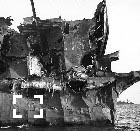
USS Independance
|
Serious damage to the aircraft carrier Saratoga, more than a 1.6 km from the blast, was due to fire. For test purposes, all the ships carried sample amounts of fuel, ordnance and airplanes. Most warships carried a seaplane on deck, which could be lowered into the water by crane, but the Saratoga carried several airplanes with highly volatile aviation fuel, both on deck and in the hangars below. The fire was extinguished and the Saratoga was kept afloat for use in the Baker shot.
The only large ship inside the 900 m radius which sustained moderate, rather than serious damage was the Japanese battleship Nagato, whose stern-on orientation to the bomb gave it some protection. As the ship from which the Pearl Harbor attack had been commanded, Nagato was positioned near the aim point to guarantee its being sunk. Since the Able bomb missed its target, that symbolic sinking would come three weeks later, in the Baker shot.
Ships beyond 600 m that had sustained sufficently low levels of damage and contamination, were re-boarded on July 1 and used for crew quarters. By 5 July all target vessels (except those sunk) had been rehabilitated to the extent necessary for the upcoming Baker event.
Fifty-seven guinea pigs, 109 mice, 146 pigs, 176 goats, and 3,030 white rats had been placed on 22 target ships in stations normally occupied by people. 10% of the animals were killed by the air blast, 15% were killed by fireball radiation, and 10% were killed during later study. Altogether, 35% of the animals died as a direct result of blast or radiation exposure.
Although the target ship the Nevada was not sunk or heavily contaminated (due to the poor targetting), had it been fully manned direct radiation from the fireball would probably have exterminated most the crew rendering her a ghostship.
|
Able damage results:
- 5 ships sunk
- 6 ships seriously damaged
- 8 ships seriously impaired efficiency
- 9 ships moderately damaged
- 43 ships negligible damage
- 22 landing craft beached at Bikini Isl.
- 14 aircraft destroyed
- 30 aircraft seriously damaged
- 10 aircraft lightly damaged
- 19 aircraft no damage
|
|
- Click on a thumbnail for a larger version
|
|
|
Shot Baker
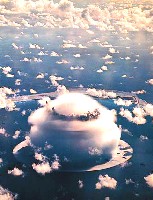
Baker 25th July 1946
|
Baker, the second shot of Operation Crossroads, was the world's fifth nuclear explosion, third nuclear test, and first underwater nuclear explosion.
As soon as the extent of damage from Able had been determined, CJTF 1 tentatively set 25 July for Baker. The news media ship USS Appalachian returned to Pearl Harbor to allow some media people to depart and others to join the group. Some observers were taken a cruise to Ponape, Truk, Majuro, and Guam islands while the Task Force prepared for Baker.
Several target ships had sustained boiler and/or stack damage. Wreckage was cleared and repairs made so that every target ship was able to steam under its own power on at least one boiler. USS Independence needed considerable work to ensure watertight integrity. The submarine Skate needed superstructure repairs, including a temporary bridge. One by one the target ships were moved to their positions in the new target array for Baker. Able blast damage inspections were completed and new instrumentation and new experiments were set up on these target ships in preparation for Baker.
Army Air Forces conducted a major rehearsal on 14 July. All Army air units participated. Locations, communications, and coordination were tested, checked, and rechecked. Then on 19 July, JTF 1 conducted a full-scale dress rehearsal, dubbed "William Day." All units of the Task Force participated fully except the air task units. Heavy cloud cover and rain limited aircraft participation in the rehearsal.
On D-1 (24 July) CJTF 1 confirmed Baker Day as 25 July and designated shot time for 08:35. Weather forecasts indicated that there would be favorable weather on that day. Evacuation of Task Force ships and personnel began immediately.
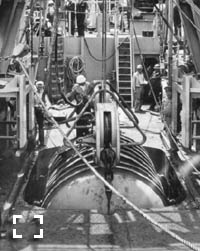
Baker caisson
|
The day before Baker, two C-54s were again sent to Enewetak and Roi islands to transport the cloud samples to Kwajalein on 25 July. Five C-54s were again positioned at Enewetak in case evacuation of essential personnel was necessary. Except for minor changes, the aircraft missions were similar to the Able shot missions. By 1735 on 24 July all but 13 support ships were clear of the lagoon. These cleared the lagoon by 0700 the following morning.
Task force personnel on the islands at Bikini were evacuated by 1555 on 24 July. Three sailors on USS Gasconade, a target ship, were somehow overlooked. They filled the yardarms with bunting (the signal that they needed evacuation) and were picked up by USS Conserver at 0530 on 25 July
The bomb was suspended 27 m beneath the surface of the lagoon from medium landing ship LSM-60. The LSM had been extensively modified to provide rigging facilities, a laboratory, and special radio receivers and transmitters. The bomb was encased in a strong, watertight, steel caisson with a coaxial cable running from it to the LSM. After the test, no identifiable part of LSM-60 was ever found, it was presumably vaporized by the nuclear fireball.
There were 68 target vessels in the array for Test Baker. Twenty-four small craft were beached on Bikini Island. The submarine USS Searaven (which had been submerged on 24 July), partially surfaced later in the day. It was finally resubmerged by 2300 on 24 July. Of the eight target submarines, six were submerged and two were on the surface for the test. Weather was not quite as important for Baker as for Able because the underwater detonation was expected to limit the cloud height and thus localize the radioactivity. Good visibility, however, was important for photography.
Baker exploded on schedule at 08:35 on 25 July 1946 with a force of 23 kilotones. The detonation command was sent by radio using coded signals.
"The flash seemed to spring from all parts of the target fleet at once. A gigantic flash -- then it was gone. And where it had been now stood a white chimney of water reaching up and up. Then a huge hemispheric mushroom of vapor appeared like a parachute suddenly opening. . . . By this time the great geyser had climbed to several thousand feet. It stood there as if solidifying for many seconds, its head enshrouded in a tumult of steam. Then slowly the pillar began to fall and break up. At its base a tidal wave of spray and steam rose to smother the fleet and move on towards the islands. All this took only a few seconds, but the phenomenon was astounding as to seem to last much longer."
- Oberver's account of the Baker detonation from a Navy PBM 15 nmi away
|
 The underwater fireball took the form of a rapidly expanding hot "gas bubble" pushing against the water, generating a supersonic hydraulic shock wave crushing the hulls of nearby ships. On the surface, the shock wave was visible as the leading edge of a rapidly expanding ring of dark water, called the "slick". Close behind the slick was a visually more dramatic, but less destructive whitening of the water surface called the "crack."When the gas bubble's diameter equaled the water depth, it hit the sea floor digging a shallow crater 9 m deep and 610 m wide. At the top, it pushed the water above it into a "spray dome," which burst through the surface like a geyser.
The underwater fireball took the form of a rapidly expanding hot "gas bubble" pushing against the water, generating a supersonic hydraulic shock wave crushing the hulls of nearby ships. On the surface, the shock wave was visible as the leading edge of a rapidly expanding ring of dark water, called the "slick". Close behind the slick was a visually more dramatic, but less destructive whitening of the water surface called the "crack."When the gas bubble's diameter equaled the water depth, it hit the sea floor digging a shallow crater 9 m deep and 610 m wide. At the top, it pushed the water above it into a "spray dome," which burst through the surface like a geyser.
During the first full second, the expanding bubble removed all the water within a 152 m radius lifting two million tons of water and seabed into the air. As the bubble rose at 762 m/s (mach 2.5), it stretched the spray dome into a hollow cylinder of spray called the "column," 1,829 m tall, 610 m wide, and with walls 91 m thick.
As soon as the gas bubble reached the air, it started a supersonic atmospheric shock wave which, like the crack, was more visually dramatic than destructive. Brief low pressure behind the shock wave caused instant fog which shrouded the developing column in a "Wilson cloud", obscuring it from view for two seconds. By the time the Wilson cloud vanished, the top of the column had become a "cauliflower," and all the spray in the column and its cauliflower fell back into the lagoon.
Meanwhile, lagoon water rushing back into the space vacated by the rising gas bubble started a tsunami-like water wave which lifted the ships as it passed under them. At 11 seconds after detonation, the first wave was 305 m from surface zero and 30 m high. By the time it reached the Bikini Island beach, 6 km away, it was a nine-wave set with shore breakers up to 5 m high, which tossed landing craft onto the beach.
Twelve seconds after detonation, falling water from the column started to create a 274 m tall "base surge" resembling the mist at the bottom of a large waterfall. Unlike the water wave, the base surge rolled over rather than under the ships. Of all the bomb's effects, the base surge had the greatest consequence for most of the target ships, as it painted them with a penetrating aerosol of highly radioactivite water.
Eight ships were sunk or capsized, eight more were immobilized or seriously damaged. Generally, ships beyond 1,370 m were undamaged. Those between 1000 m and 1,370 m sustained only slight damage. Those between 820 and 1000 yards suffered moderate damage. Those inside 820 meters were seriously damaged or were sunk.
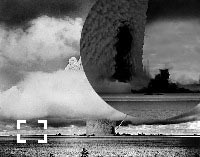
Detail of the USS Arkansas (large vertical shadow)
|
Arkansas was the closest ship to the bomb other than the ship from which it was suspended. The underwater shock wave crushed the hull on the starboard side facing the balst, and rolled the battleship over onto its port side. It also ripped off the two starboard side propellers and their shafts, along with the rudder and part of the stern, shortening the hull by 8 meters. Contrary to popular belief, Arkansas was not lifted vertically by the blast, the dark area is caused by Arkansas's hull interfering with the development of the spray column, creating a hole in the plume. Forensic examination of the wreck during multiple surveys since the test conclusively show that structural failure of hull plating along the starboard side allowed rapid flooding and capsized the ship.
The explosion released aproximately 1.3 kilos of fission products. These materials were mixed with the millions of tons of water and sand that were lifted into the spray column, and dumped back into the lagoon and onto the atolls. The resulting radioactive contamination of the lagoon and the target ships, while anticipated, caused far greater problems than expected.
At 0912 the drone control ship, Beqor, began moving two drone boats from the lee of Eneu towards the target array using directions from the orbiting drone control TBMs as in the Able test. Each boat took samples of lagoon water before returning to its anchorage. The drone boats were so radiologically contaminated that boarding parties from Beqor could not go aboard. Early reports from radiological reconnaissance PBMs and drone boats indicated that the lagoon and surrounding atmosphere were intensely radioactive. One drone boat recorded 730 R/24 hours near the center of the target array.
Salvage units entered the lagoon at 1015 and began checking and boarding target vessels. A total of 49 support ships with 14,920 personnel had entered the lagoon by the end of 25 July. Sailors tried to scrub off the radioactivity with brushes, water, soap, and lye. Nothing worked, short of sandblasting to bare metal.
Only pigs and rats were used in the Baker test. All the pigs and most of the rats died. Radiation from a contaminated environment is continuous and cumulative. With the Able test, lethality was determined by proximity to the fireball and its pulse of radiation. With Baker, lethality was determined by the amount of time spent aboard contaminated ships. Several days elapsed before sailors were able to reboard the target ships where test animals were located; during that time the accumulated doses from the gamma rays produced by fission products became lethal for the animals.
By August 10th (16 days after the test) the cleanup program was deemed both futile and dangerous and was terminated. The decontamination failure ended plans for a third deepwater shot codenamed Charlie originally scheduled for the spring of 1947. The test intended for Charlie was conducted later in 1955 as Operation Wigwam.
The 167 Bikini residents who were moved to Rongerik Atoll prior to Crossroads, proved unable to feed themselves in their new environment and were facing starvation. In March 1948 they were evacuated to Kwajalein Atoll, and settled onto another uninhabited island, Kili, in November. With only one third of a square mile, Kili has one tenth the land area of Bikini and, more important, has no lagoon and no protected harbor. Unable to practice their native culture of lagoon fishing, they became dependent on food shipments.
Their desire to return to Bikini was thwarted indefinitely by the U.S. decision to resume nuclear testing at Bikini in 1954. During the spring and summer months of 1954, 1956, and 1958, twenty-one more nuclear bombs were detonated at Bikini, yielding a total of 75 megatons, equivalent to more than three thousand Baker bombs. There was a brief attempt to resettle Bikini again from 1974 until 1978 which was aborted when health problems from radioactivity in the food supply caused the atoll to be evacuated again.

| - DNA 6032F - Defense Nuclear Agency report - Crossroads
|
|
- Click on a thumbnail for a larger version
|
|
|
|
 |





